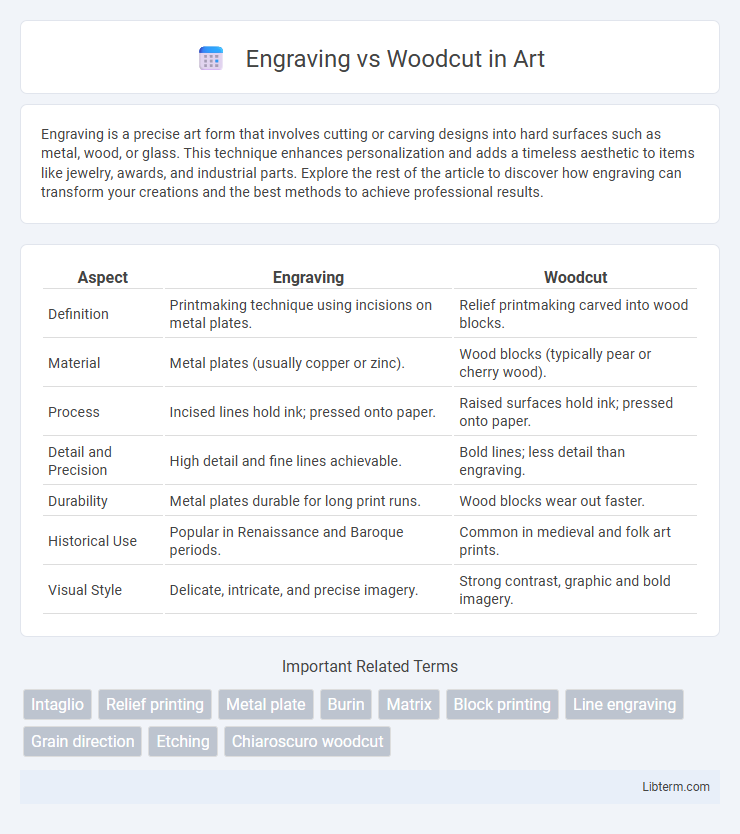Engraving is a precise art form that involves cutting or carving designs into hard surfaces such as metal, wood, or glass. This technique enhances personalization and adds a timeless aesthetic to items like jewelry, awards, and industrial parts. Explore the rest of the article to discover how engraving can transform your creations and the best methods to achieve professional results.
Table of Comparison
| Aspect | Engraving | Woodcut |
|---|---|---|
| Definition | Printmaking technique using incisions on metal plates. | Relief printmaking carved into wood blocks. |
| Material | Metal plates (usually copper or zinc). | Wood blocks (typically pear or cherry wood). |
| Process | Incised lines hold ink; pressed onto paper. | Raised surfaces hold ink; pressed onto paper. |
| Detail and Precision | High detail and fine lines achievable. | Bold lines; less detail than engraving. |
| Durability | Metal plates durable for long print runs. | Wood blocks wear out faster. |
| Historical Use | Popular in Renaissance and Baroque periods. | Common in medieval and folk art prints. |
| Visual Style | Delicate, intricate, and precise imagery. | Strong contrast, graphic and bold imagery. |
Introduction to Printmaking Techniques
Engraving involves incising detailed images into a metal plate, allowing for precise lines and rich textures, making it a foundational intaglio printmaking technique. Woodcut, a relief printing method, uses carved wooden blocks to create bold, high-contrast images by printing from raised surfaces. Both techniques have significantly influenced printmaking history, offering distinct artistic expressions based on their materials and processes.
What is Engraving?
Engraving is a printmaking technique where an image is incised into a metal plate, typically copper or steel, using a sharp tool called a burin. This method allows artists to create highly detailed lines and intricate textures by carving grooves that hold ink for printing. Engraving's precision and fine line work distinguish it from woodcut, which involves carving into a wooden block and produces bolder, more graphic images.
What is Woodcut?
Woodcut is a relief printing technique where an artist carves an image into the surface of a wooden block, removing the non-printing areas to create raised design elements. Ink is applied to the raised surfaces, which are then pressed onto paper or fabric to produce a print. This traditional method emphasizes bold lines and contrasts, distinguishing it from intaglio techniques like engraving.
Historical Development of Engraving and Woodcut
Engraving originated in the 15th century, pioneered by artists like Martin Schongauer who used metal plates to create detailed, precise images for printing. Woodcut, dating back to early Chinese art before reaching Europe in the 14th century, involved carving images into wooden blocks to produce bold, high-contrast prints suitable for mass reproduction. The evolution of engraving allowed for finer lines and greater detail compared to the rough, textured appearance characteristic of woodcut prints, influencing the artistic and commercial printing practices of the Renaissance period.
Materials and Tools Used
Engraving primarily utilizes copper or steel plates and sharp tools like burins to carve fine, precise lines directly into the metal surface. Woodcut involves carving images into wooden blocks, typically using gouges and knives to remove negative space while leaving the raised design for printing. The durability of metal plates in engraving allows for finer detail and longer print runs compared to the softer, more accessible wood used in woodcuts.
Process and Technique Differences
Engraving involves incising a design onto a metal plate using a burin, creating fine, precise lines ideal for detailed images, while woodcut is a relief process where the artist carves away the negative spaces from a wooden block, leaving raised areas to be inked and printed. Engraving requires meticulous control to etch intricate details beneath the surface, whereas woodcut emphasizes bold, contrasting shapes by removing wood from the block's surface. The engraving plate can produce multiple high-resolution impressions with crisp linework, whereas woodcuts yield prints with more graphic, textured qualities due to the grain of the wood.
Visual Characteristics: Engraving vs Woodcut
Engraving produces fine, precise lines with smooth gradients and intricate details, resulting in a highly polished and refined visual appearance. Woodcut features bold, contrasting lines with a more textured, rough quality, emphasizing strong shapes and patterns due to the carving process on a relief surface. The visual characteristics of engraving tend to be more delicate and detailed, while woodcuts display a graphic, expressive aesthetic.
Artistic Styles and Applications
Engraving features intricate, precise lines created by cutting into metal plates, making it ideal for detailed portraits, fine art prints, and currency design. Woodcut employs bold, contrasting shapes carved from wooden blocks, often used for book illustrations, posters, and traditional folk art with a strong graphic appeal. Both techniques showcase distinct textures and line qualities, influencing their application in artistic styles ranging from realism in engraving to expressive, high-contrast visuals in woodcut.
Pros and Cons of Each Method
Engraving offers precise and intricate detail, making it ideal for fine art prints and currency designs but requires skilled craftsmanship and expensive tools. Woodcut is more affordable and allows bold, expressive lines, yet it produces less fine detail and wears down faster with repeated use. Both methods provide distinct textures and aesthetic qualities, with engraving excelling in durability and precision, while woodcut emphasizes simplicity and rustic charm.
Choosing Between Engraving and Woodcut
Choosing between engraving and woodcut depends on the desired detail and texture of the artwork. Engraving offers precise, fine lines ideal for intricate, high-contrast images, while woodcut provides bold, graphic qualities with a tactile, rustic feel. Consider the printing process and final use, as engraving suits delicate prints and commercial reproductions, whereas woodcut excels in expressive, traditional designs.
Engraving Infographic

 libterm.com
libterm.com